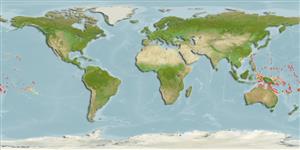>
Blenniiformes (Blennies) >
Blenniidae (Combtooth blennies) > Salariinae
Etymology: Cirripectes: Latin, cirrus = curl fringe + Greek, pektos, -e, -on = made of several parts solidly united (Ref. 45335); fuscoguttatus: Specific epithet 'fuscus' meaning dusky or dark and 'guttatus' meaning spotted, referring to the dark brown spots on head and body..
More on authors: Strasburg & Schultz.
Environment: milieu / climate zone / depth range / distribution range
Οικολογία
Θαλασσινό(ά) Υφαλόφιλο(α); εύρος βάθους 0 - 8 m (Ref. 529). Tropical; 27°N - 25°S
Pacific Ocean: southern Taiwan to Tuamoto Islands, south to Tonga; throughout Micronesia.
Length at first maturity / Μέγεθος / Βάρος / Age
Maturity: Lm ?, range 6 - ? cm
Max length : 10.6 cm SL αρσενικό/απροσδιόριστο; (Ref. 529)
Ραχιαίες άκανθες (συνολικά) : 12; Μαλακές ραχιαίες ακτίνες (συνολικά) : 13 - 15; Εδρικές άκανθες: 2; Μαλακές εδρικές ακτίνες: 14 - 16; Σπόνδυλοι: 30. Diagnosis: Dorsal fin XII, 14, membrane attached to caudal fin, with deep notch above last spine, first spine almost same or slightly higher than second; anal fin II, 15; pectoral rays 15; pelvic fin I, 4; caudal fin procurrent rays 11-14. Vertebrae 10 + 20. LL, without scales and scalelike flaps; LL tubes 0-3 (sometimes up to 5), canal ends below 13th dorsal spine to caudal-fin base. Upper lip crenulae 40-55. Gill rakers 22-32. Cephalic sensory pore system complex. Cirri: supraorbital 18-42 (usually 20-37); nasal 7-32 (usually 11-27); nuchal 47-66 (usually 50-60), in 4 groups with 2 or more sometimes connected basally by a frenum, dorsalmost groups usually meet or overlap at midpoint on nape, ventralmost group on each side borne on broadly expanded flap. Head with dark brown spots on pale background; orangish red iris; yellow pelvic fins; pectoral fins spotted on proximal half. (Ref. 529).
Facultative air-breathing in the genus (Ref. 126274); Typically found in the surge zone of coral reefs from 0-8 m deep (Ref. 529). Oviparous. Eggs are demersal and adhesive (Ref. 205), and are attached to the substrate via a filamentous, adhesive pad or pedestal (Ref. 94114). Larvae are planktonic, often found in shallow, coastal waters (Ref. 94114).
Oviparous, distinct pairing (Ref. 205). Urogenital orifice of male genital papilla located basally between 2 widely separated slender filaments on a fleshy swelling behind anus; testes bulbous with length equal to its width (Ref. 529).
Williams, J.T., 1988. Revision and phylogenetic relationships of the blenniid fish genus Cirripectes. Indo-Pac. Fish. (17):78 p. (Ref. 529)
IUCN Red List Status (Ref. 130435)
Threat to humans
Harmless
Human uses
αλιεία: χωρίς ενδιαφέρον
Εργαλεία
Special reports
Download XML
Διαδικτυακές πηγές
Estimates based on models
Preferred temperature (Ref.
123201): 25.2 - 29.4, mean 28.3 °C (based on 1194 cells).
Phylogenetic diversity index (Ref.
82804): PD
50 = 0.5000 [Uniqueness, from 0.5 = low to 2.0 = high].
Bayesian length-weight: a=0.01072 (0.00480 - 0.02393), b=3.01 (2.82 - 3.20), in cm total length, based on LWR estimates for this (Sub)family-body shape (Ref.
93245).
Τροφικό Επίπεδο (Ref.
69278): 2.0 ±0.00 se; based on food items.
Ελαστικότητα (Ref.
120179): Υψηλό, ελάχιστος χρόνος για διπλασιασμό πληθυσμού < 15 μήνες (Preliminary K or Fecundity.).
Fishing Vulnerability (Ref.
59153): Low vulnerability (10 of 100).
Nutrients (Ref.
124155): Calcium = 132 [69, 230] mg/100g; Iron = 0.871 [0.504, 1.445] mg/100g; Protein = 18.4 [17.2, 19.5] %; Omega3 = 0.12 [0.07, 0.20] g/100g; Selenium = 18.2 [9.9, 36.2] μg/100g; VitaminA = 127 [35, 455] μg/100g; Zinc = 2.55 [1.70, 3.67] mg/100g (wet weight);
